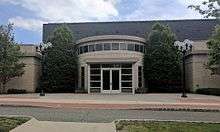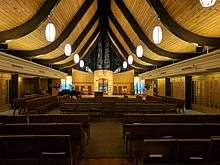Temple Emanu-El of West Essex
Temple Emanu-El of West Essex in Livingston, New Jersey was founded in 1955 and is one of the oldest Reform synagogues in the West Essex section of New Jersey. Emanu-El means "God is with us" in Hebrew.
| Temple Emanu-El of West Essex | |
|---|---|
.jpg) | |
| Religion | |
| Affiliation | Reform Judaism |
| Ecclesiastical or organizational status | Defunct. Merged with Temple Sinai in 2017. |
| Leadership | Interim Rabbi Mark Disick
Interim Cantor Lori Corrsin Rabbi Emeritus Peter Kasdan |
| Location | |
| Location | Livingston, New Jersey |
| Architecture | |
| Architect(s) | Blake and Nest |
| Completed | 1962 |
| Direction of façade | West |
| Website | |
| http://www.emanuel.org | |
News reported in early 2017 that the synagogue would be closing for financial reasons and was "taking steps to merge" with a nearby congregation. By 2018, the congregation had formally merged with Temple Sinai in Summit, NJ although in many ways it was more of an absorption.
The synagogue building was sold and has become the Living Stone Christian Church.[1] The former early childhood daycare and Hebrew school buildings have become part of a Mandarin (Chinese) and Spanish language immersion center.[2]
History

The congregation was founded by 11 families seeking a Reform Jewish service in the growing suburb of Livingston, New Jersey. By the fall of 1955, 56 families had been recruited and High Holiy Days services were led by student Rabbi Milton Rosenfeld from the Hebrew Union College. In 1956, the congregation purchased a hot dog stand off Northfield Road as their permanent home. By 1961, ground had been broken on that very spot to build their own sanctuary designed by renowned architects Peter Blake and Julian Neski. The new building, with its soaring peaked roof, is a landmark in Livingston and evokes the Israelites' Tent of Meeting in the desert wilderness.[3] Most visitors think it looks like Noah's Ark.
A major expansion of the building including a new main entrance, office space, the library, and the Holocaust Remembrance Center was completed in 2004. This campaign also included a new Early Childhood Center (ECC). In 2005-2006, the congregation celebrated its 50th anniversary with year-long programs and events. Although smaller than most of the area congregations, it is known for its haimish attitude and welcoming atmosphere. During the Summer of 2011, the sanctuary was renewed, making it both more modern, and more comfortable. Some changes included a new sound system, bimah, ner tamid, and many new features.
Temple Emanu-El is a member of the Union for Reform Judaism.
In February 2017, The New Jersey Jewish News and the West Essex Tribune both reported that the congregation voted to disband at the end of June, and the temple's board is negotiating a merger with Temple Sinai in the nearby town of Summit. The Jewish News quoted from an email sent by the temple president that cited financial reasons for the decision.[4][5]
As of June 23, 2017, neither the temple's website nor its Facebook page had any apparent reference to the impending change.
Social action
With the creation of a Social Action Committee in 1964 and the hiring of Rabbi Peter Kasdan in 1971, Emanu-El established itself as a leader on social justice issues. Kasdan organized a nationwide Reform Jewish boycott of grapes in support of the United Farm Workers. The synagogue participated in rallies, marches, and programs on issues such as Soviet Jewry, Ethiopian Jews, Abortion Rights, and Vietnamese Boat People. The congregation adopted and supported one Vietnamese family for years. In more recent years, issues such as Reform rights in Israel,[6] Darfur, Gay & Lesbian rights, and Jewish genetic diseases[7] have been at the forefront.
Other programs
Expanding approaches to welcoming interfaith families and Jews-by-Choice, Temple Emanu-El is an inaugural participant in the STAR Synagogue's "Calling Synagogue Home" project.[8]

Temple Emanu-El received an Honorable Mention for the URJ's Congregation of Learner's Award for Adult Education[9] at the URJ Biennial in 2007. Numerous individual Temple members have achieved at least 100 hours of Jewish study to earn the URJ Keva Award[10] since the program was brought to the Temple in 2005.
Professional staff
- Bookkeeper: Kesef Accounting
- Admin. Assistant: Elainia Graham
- Director of Congregational Learning: Susan Cosden
- Religious School Admin: Ruth Cash
- Director of Early Childhood Center: Ellen Levitt
- Admin. Assistant to ECC: Anita Pittman
 A view from inside the sanctuary
A view from inside the sanctuary
Clergy
Rabbi Kasdan led Temple Emanu-El for 30 years until his retirement in 2001 when he was named Rabbi Emeritus. Known most widely for his social action work,[11] Kasdan created and was president of the Livingston Interfaith Clergy. He led 8 adult bat mitzvah classes and was widely regarded for his work with youth through the Religious Action Center, Kutz Camp, and NFTY being awarded NFTY life membership in 1984[12] and the Rabbi Samuel Cook Award for lifetime contribution in youth work in 2007 by the Central Conference of American Rabbis.[13]
The congregation was led from July 1, 2012 until May 18, 2016 by Rabbi Greg Litcofsky. Originally from Philadelphia, Pennsylvania, Litcofsky had been an Associate Rabbi at Temple Shir Tikva in Wayland, Massachusetts. He encouraged a climate of diversity and integration among Temple committees and the Jewish community. Programmatic focus includes worship, youth activities, adult education, outreach, social action, and leading his first synagogue-wide trip to Israel in 2013.
Rabbis:
- Milton Rosenfeld (1955–1957)
- Harold T. Miller (1957–1959)
- Herbert Rose (1959–1963)
- Kenneth Rivkin (1963–1971)
- Peter E. Kasdan (1971–2001) (Emeritus 2001–present)
- Daniel E. Levin (2001–2004)
- Mark Kaiserman (2004–2012)
- Greg Litcofsky (2012–2016)
- Marc Disick (2016-2017)
Cantors:
- Judah Livingston Smith (1956–1957)
- Norman Swirling (1957–1959)
- Hans Cohn (1959–1961)
- Sheldon Torn (1961–1962)
- Israel Weisman (1962–1964)
- Erwin Nathaniel Borses (1964–1965)
- Louis E. Davidson (1965–1982)
- Michael Manevich (1982–1989)
- Pat Hickman (1989–1991)
- Carla Reynolds (1991–1993)
- Donna Faye Dower (1993–1999)
- Renata Krushkova (1999–2003)
- David Rosen (2003–2006)
- Sharon Brown-Levy (2006–2014)
- Joshua Gavin Finkel (2014–2016)
- Lori Corrsin (2016-2017)
Notable members
- Mike Chernoff (born c. 1981), general manager of the Cleveland Indians
References
- "When We Meet - Living Stone Christian Church". lsccnj.org. Retrieved 2018-01-12.
- "NJ Spanish and Mandarin Chinese Schools | Jump! Immersion School". BC Pie. Retrieved 2018-01-12.
- Official Temple History Archived 2007-06-30 at the Wayback Machine
- Ginsberg, Johanna. "Temple Emanu-El in Livingston Set to Close" (Feb. 23, 2017). New Jersey Jewish News. Retrieved 8 March 2017.
- "Temple Emanu-El to Close After 61 Years | WestEssexTribune.net | West Essex Tribune | Livingston's Community Newspaper". www.westessextribune.net. Retrieved 2017-03-15.
- Jewish News Weekly Article from October 17, 1997 on Pluralism Efforts
- Story on Kasdan support of Canavan Foundation
- List of STAR-CSH Participants
- URJ Congregation of Learner's Brochure Archived 2012-07-16 at Archive.today
- About Keva Archived 2008-02-21 at the Wayback Machine
- NY Times Article from October 3, 1999 Story on Kasdan
- List of all NFTY life membership recipients Archived 2011-05-16 at the Wayback Machine
- CCAR Newsletter, January 2007, p. 3